Go Back to current column
Lubec Photo Workshops – Summer, 2011 ... AND
Umbria Photo Workshops - Fall, 2011 (see below!)
'Those Nice Bright Colors...'
How Kodak hastened Kodachrome's demise
By Frank Van Riper
Photography Columnist
In all the space that has been given over to the death of Kodachrome--arguably the greatest color film of all time—hardly any has been devoted to the fact that its death, though perhaps inevitable in today’s digital market, was hastened by Eastman Kodak’s conscious decision decades ago to abandon firm control over the processing of this demanding, yet ultimately magnificent, slide film.
Which is not to say that had Kodak continued to support this landmark emulsion it still would be in wide use—I am not so much of a film-loving troglodyte to believe this. What I am saying is that bean-counting, standards-lowering actions by Eastman Kodak in the handling of Kodachrome film a good twenty-five years ago all but handed the slide film market over to its chief foreign competitor Fuji Film, Inc. This, in turn, narrowed the available market for Kodachrome, especially among professional photographers, to such an extent that the film was effectively doomed. Last December the last remaining Kodak processing lab in the country—Dwayne’s Photo in rural Parsons, Kansas—announced it was processing its last rolls of Kodachrome.
 |
| After decades all that is left is a T-shirt. ©Frank Van Riper |
[The machine doing the job was marked for scrap since Kodak, the only source for Kodachrome’s highly specialized chemistry, had stopped making the chemicals to process the film. Dwayne's had set a December 30th processing deadline, but the frantic crush of folks wanting to soup their film or lose it forever forced the lab to push that back a couple of weeks into the new year.]
Photographers of a certain age (myself included) remember the thrill of opening little yellow boxes containing cardboard mounted Kodachrome slides—the gold standard of color photography. The sharpness, the saturation, the vividness of the colors captured by the film so outshone the performance of the competition—Agfachrome, Anscochrome, Perutz (Perutz!?), even Kodak’s other slide film Ektachrome—that it almost was laughable.
Introduced in 1935, when dinosaurs walked the earth, Kodachrome not only was prized for the way it rendered real-world color, but also for its longevity.
Here was a film that rivaled black and white for its archival qualities. This, it should be noted, was roughly at a time when Ektachrome and other E-6 slide films were notorious for fading, even in dark storage . I remember once years ago looking through a bunch of 35mm Kodachrome slides shown to me by a colleague who had lived in London during World War 2. The reds on the famed London double-decker buses, dating back to the time of the Blitz, were as bright and true as they had been a generation earlier. And this was no fluke; everyone who used Kodachrome regularly had these stories. [And, in fairness to E-6, the permanence of these films, especially Fujichrome Velvia, has improved markedly over the years, but Kodachrome was, and likely always will be, the archival color champion.]
Then there was the way the film rendered the image itself.
“The most astonishing thing about opening your first box of Kodachromes was discovering that, in fact, your lenses really WERE sharp,” noted famed photojournalist David Burnett in his blog “We’re Just Sayin.”
In his fledgling days as a photojournalist in the 1960s David said he always was disappointed in his color photos (“They were never really sharp. The color always had a kind of fogginess, a softness which made me wonder what I was doing wrong.”)
But with Kodachrome that all changed. “Somehow, the film was just waiting to etch those images (onto its emulsion) in a way no other film could do,” Burnett recalled.
Such nice bright colors, as Paul Simon sang—and not just the greens of summer. In fact “Kodachrome red” was shorthand for how intensely the film registered the color red, just as “Fujichrome green” became the descriptive watchword for that great film.
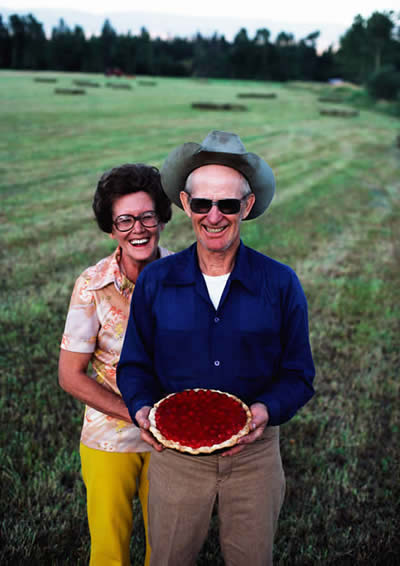 |
| The Lubbers-champions at pie, both baking and eating. Missoula, Montana, 1982. © David Burnett |
And, with Kodachrome, if you shot it sharp, it came out sharp—sharper than any color picture you ever made on any other film. The intricate, multi-bath process for souping Kodachrome insured that individual colors were rendered optimally, with sharply delineated edges that enhanced the appearance of overall clarity.
Of course there were problems with the film, but in those early years, when the world moved at a blessedly slower pace, none seemed all that great.
For one, the original Kodachrome was glacially slow in terms of ISO (called ASA back then.)
Older Kodachrome veterans remember shooting the film at an ISO of ten. (n.b.: that’s not a typo. “Ten”—as in one less than eleven.)
As in more than five stops slower than your average 400 speed color film today. It’s a wonder we got any pictures at all, much less ones that knocked our socks off.
But, given the fact that the original Kodachrome was meant to be shot outdoors (“makes you think all the world’s a sunny day,” remember?) this was no great hardship. In later years—during the time when I was shooting Kodachrome almost exclusively--the engineers at Big Yellow had tweaked the ISO up to 64, making Kodachrome an even more wonderful film. “The first roll [of 64] which came my way was in early 1974,” Dave Burnett recalled. Just finishing his coverage of the presidential campaign of Valery Giscard d’Estaing for Time magazine, Burnett was able to score a quick window-lit portrait session with the new French leader and included in the take he shipped to New York a roll of headshots done on the new Kodachrome.
“A week later one of those frames was the cover of Time magazine.”
The operative words here are “a week later,” because time—or the lack thereof--always was Kodachrome’s enemy, especially for photojournalists on deadline like Burnett, even though they loved the film.
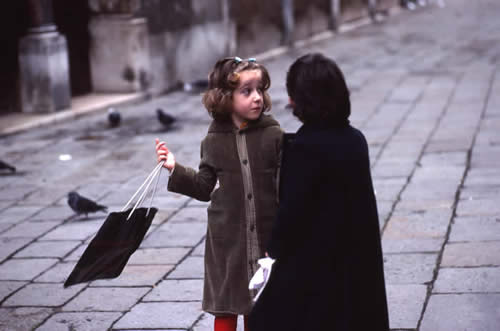 |
| I made this shot in Venice on our honeymoon in 1984. I love the skin tones on the girl, as well as her red leggings and her expression. Her friend in the foreground creates an unsettling atmosphere for me. © Frank Van Riper |
The intricate, temperamental, multi-bath ritual of processing Kodachrome routinely added days to its turnaround time, especially when compared to E-6 films, which ultimately could be processed by photographers themselves (the process was that simple by comparison), or in one-hour processing by a professional lab.
And here we see the first harbingers of Kodachrome’s demise: not because of the film necessarily, but because of Kodak’s dubious decisions about its processing.
The added turnaround time for Kodachrome was not just a function of its multi-layered souping procedure, but also a reflection of the fact that there were precious few labs around the country, much less the world, to handle it. This was because decades ago Kodak (unlike Fuji) made a conscious decision not to use then-existing technology to enter the mini-lab market to process Kodachrome, preferring instead to keep things in-house via huge labs spaced around the country.
“The technology existed to create small mini Kodachrome processing machines which could reasonably be installed at any good-sized one-hour lab in the country,” David Burnett recalled. It seemed reasonable to assume that, given such a setup, consumers, both pro and amateur, would continue to use Kodachrome in huge numbers, given the film’s undisputed quality. “But for reasons known only to the geniuses at Kodak’s planning department, no serious consideration was ever given to supporting that project.”
In hindsight one can see the start of a vicious cycle. Though a superb film—made even greater in the 1980s with the introduction of Kodachrome 200, a godsend to sports and available light shooters—Kodachrome’s long turnaround time was becoming even more of a problem for photojournalists faced with ever-shortening deadlines, as well as technology like satellite transmission that enabled publications to demand—and get—photographs almost soon as they were shot. (And remember: this was all before digital.)
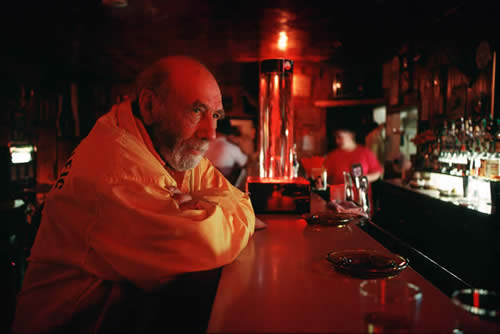 |
Bar, Grand Marais, Michigan © David Burnett
This gorgeous available light portrait made on Kodachrome 200 illustrates why the film was so prized by indoor shooters. |
It got to the point where only journalists who were NOT on deadline could use the film—and even then it was a trial. Photojournalist Bill Putnam, for example, who has embedded with troops in Iraq and Afghanistan, and shot conflict in other dicey spots as well, very well may be, in his words, “the last snapper to shoot a war on Kodachrome.”
“I'm a late comer to the wonders of Kodachrome but what I loved about it was the colors were always spot on,” noted Bill, whose show, “Abu in Bermel: Faces of Battle from Afghanistan,” opened recently at St. Vincent’s College in Latrobe, Pa. “I shot most of my chromes in Iraq and Afghanistan….The lighting and color in each place was spotty and mundane, but the film always held up. Always.
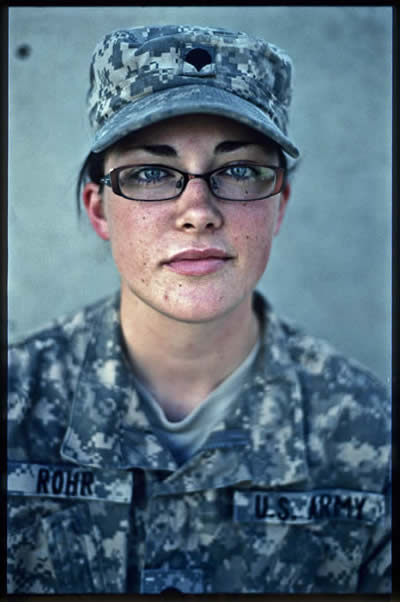 |
| US Army medic Jenna Rohr, part of photojournalist Bill Putnam's striking series of Kodachrome portraits in Afghanistan. (c) Bill Putnam |
“I only had a few issues and those were storage. It could be months between the shoot and developing. That time was nerve-wracking. I ended up storing the rolls in a ziploc bag in the bottom of a fridge or at the bottom of a duffle in a well air-conditioned room. That's what I did for my 'Khromes' shot in Afghanistan - I kept it in the company commander's office fridge.
“I chose to shoot [Kodachrome] there because the colors would, to me, more accurately render the high desert and mountains…and help me make better portraits than what I could do digitally.
“Digital is great but film, to me again, captures something more. Kodachrome 25, 64 or 200 had that for me." [Bill Putnam’s take, it should be noted, was among the last rolls of Kodachrome ever processed—at Dwayne’s Photo in Parsons, Kansas.]
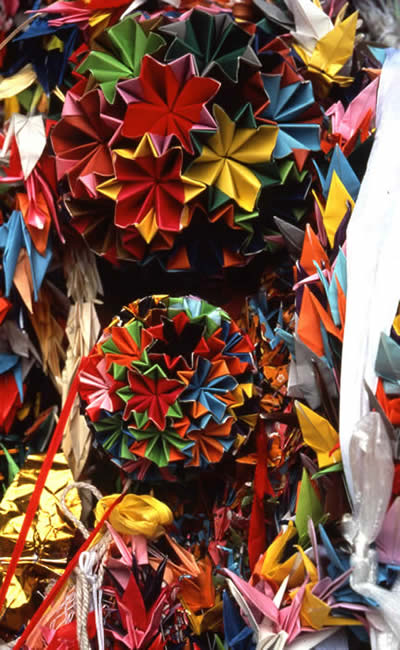 |
Hiroshima Origami © Frank Van Riper
I made this photo in 1979 at ground zero, Hiroshima. It is a memorial to the children killed in the US atomic attack that ended World War 2. |
Despite this kind of devotion to the film, Kodak years ago convinced itself there simply was no demand for Kodachrome anymore. This, of course, ignored the fact that Kodak itself was the prime agent in stifling that demand because of its processing protocol. With the numbers for Kodachrome declining, Kodak then made the decision that sealed Kodachrome’s fate: it began shuttering its own processing plants and farmed out the job of processing Kodachrome to contracting labs—of varying quality, to say the least.
Oh, the horror stories.
Not only was the turnaround time at these ersatz Kodak labs worse than ever, the quality of the processing—a point of pride with Kodak engineers and chemists of an earlier day—too often was not just slovenly, but downright dreadful.
Noted blogger A.T. Burnett several years ago: “I was certainly far from a pro but the quality was too low [even] for me, and as far as turnaround time goes, as excessive as it got, the big worry was getting it back at all. Kodalux [one of the contracting labs] also had trouble with filling those pesky cutouts in the slide mount with film. Could they have also decided to save money on refuse pick-up fees by dumping the floor sweepings in their film baths?”
My own personal epiphany came in the early 80s with several rolls of Kodachrome that (happily, I guess) I had shot for myself, not for a client. Damn near every slide had a sickly magenta cast—such a contrast to the vibrant Kodachrome slides I had come to expect in every yellow box. The culprit obviously was piss-poor processing—was nobody watching this stuff?
After years of happy use, that was the last time I ever shot Kodachrome.
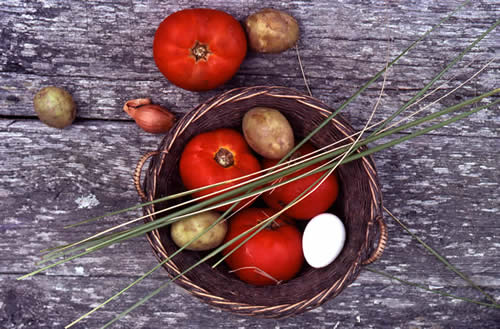 |
Nancy's Tomatoes © Frank Van Riper
The early 80's on an overcast morning on Nantucket. The tomatoes cried out to be photographed. The sea grass happened to blow on top of the basket as I was making the outdoor shot. This is one of the last images I made on Kodachrome. |
And, sadly, given the glorious history of this great film, I was not alone.
Veteran magazine shooter Kay Chernush, whose commercial and personal work regularly takes her all over the world, remembers two huge disasters, one with Kodak’s own once-great lab on Choke Cherry Lane in Gaithersburg, Md., the other with a contractor lab in San Francisco
“The first bad one was with the lab out on Choke Cherry….I had shot about 24 rolls on an assignment for a big defense contractor -- M1 tanks on maneuvers shooting live ammunition. Not something you can do over! When the film came back, I received 24 little yellow boxes of processed film, and 17 rolls of fresh K64 (because) seventeen rolls were totally ruined. I am talking washed out cyan and pale green cast. Seventeen rolls!
“When I insisted on talking to the plant manager, I was told sorry, there had been ‘a break in the line’ and the film sat in the chemicals too long. They couldn't get the line started up in time to save the film.
“My second worst experience was with a Kodak-approved lab in San Francisco.The film came back with purple and magenta blobs on many many frames. Bleach inadvertently got into the chemicals.
“Of course this doesn't address the issue of scratches (always on your best frame) or pronounced color shifts in magenta or cyan. Sigh.
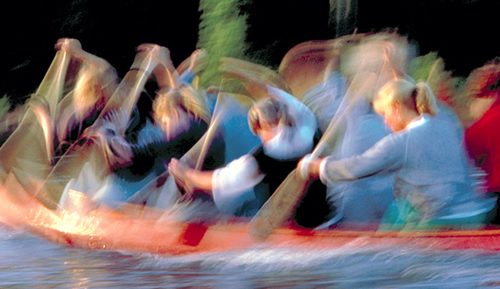 |
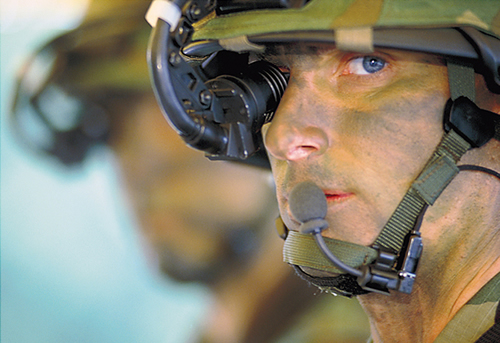 |
Top: Teamwork Bottom: High-Tech Warriors
© Kay Chernush
|
“The really scary thing was some time after the first incident, when ASMP [the American Society of Media Photographers] organized a ‘behind-the-scenes’ visit to the Choke Cherry lab. It seemed like the lab's top priority was processing prints for the amateur market. They had no tracking system for Kodachrome professional films (remember those?) -- they couldn't tell us how many rolls of Kodachrome 64 P went through the lab in a given week or month. However, they were extremely proud of how they could color correct someone's 4x6 snapshots. They operated out of shoe boxes. It was like a scene from some Marx brothers movie.
“When I related my horror stor(ies) and asked how often something like that happened, I was told ‘Well, more often than you'd think.’ When I pressed, the answer was, ‘Well maybe 2 or 3 times a week, but usually we get the line started before its too late.’
“All I can say is…Viva Digital!”
[Postscript: Christopher K. Veronda, manager of corporate communications for Kodak, responded to this column: “The fact that Kodak went to such lengths to keep the film alive for 75 years reflects our recognition that it was an iconic product with many loyal fans. That said, it had been long evident that most photographers had chosen to capture images with newer technologies -- film and digital.”]
Umbria Photo Workshops, Fall, 2011
Join internationally acclaimed husband and wife photographers Frank Van Riper and Judith Goodman for a weeklong photographic workshop under glorious fall skies in one of Italy’s most beautiful regions. This trip is limited to only six participants.
Frank and Judy, authors of the award-winning book Serenissima: Venice in Winter, will share their image-making techniques with a small group during a week covering everything from landscape photography in the verdant hills of Umbria to location portraiture in its closely held olive fields and vineyards.
Participants will travel by guided excursion to several of Umbria’s storied hill towns, including Perugia and Assisi, and receive individual attention during daily critiques.
Package includes 7 nights in the fully restored 17th century villa Fattoria Del Gelso in Cannara, located on a 40-hectare working farm literally walking distance from colorful shops and restaurants and centrally located in the shadow of Assisi. Attentive staff are on hand daily.
This is a trip designed for relaxed learning and sightseeing via foot, bicycle and van, taught by two experienced location photographers whose work has been exhibited in and acquired by major museums in the United States. Frank and Judy are molto simpatico teachers who will turn your photographic vacation into a once-in-a-lifetime adventure.
October 15-22, 2011
Price per person: €1800 (convert to dollars)
Single supplement 400 Euro
Limited to 6 participants
Package includes:
--7 nights in the private villa Fattoria del Gelso
--welcome and farewell dinner
--all breakfasts
--vineyard tour and private lunch
--pizza-making party at the villa
--daily wine and antipasto happy hour
--individual critique and instruction
--private guided walking tours
--ground transportation throughout your stay
—FURTHER INFORMATION: www.experienceumbria.com
Lubec Photo Workshops at SummerKeys – Summer, 2011
This summer, Judy and I will once again be teaching three hands-on photography workshops in Lubec Maine, sponsored by the SummerKeys Music school. (www.summerkeys.com)
Our dates for summer 2011will be as follows:
July 11th through 15th
July 25th through 29th
August 8th through 12th
Classes are limited to only six participants each week. Each class includes personal instruction, ongoing portfolio review and a wide range of location photography, including portraiture, landscape and night shooting. Each week’s class ends with a slide show of students’ best work that is open to the public.
Since their inception in 2009, Judy and I have tried to make our workshops a simpatico experience for all, regardless of skill level. There are no entrance requirements—all you need is a digital camera capable of manual operation and a desire to make pictures in one of the most beautiful areas of the country.
Watch the SummerKeys website www.SummerKeys.com for registration information, further details and pricing. Or contact us directly at GVR@GVRphoto.com
We look forward to hearing from you and to seeing you in Lubec!
Faces of the Eastern Shore
Order Frank Van Riper’s classic look at life on the Chesapeake, Faces of the Eastern Shore, for only $15 (reg. $19.95), plus s/h.
Published in 1992 and printed in duotone, this 10”x 9” quality paperback was featured in the Baltimore Sun, Washington Post and numerous other publications for its superb location portraiture and lyrical text.
Said author James A. Michener in his foreword: “What this rascal has done is belatedly to illustrate my novel, Chesapeake, and superbly.”
Contact Frank directly for copies of this now out-of-print classic: GVR@GVRphoto.com
Frank Van Riper is a Washington-based photographer, journalist, author and lecturer. He served for 20 years in the New York Daily News Washington Bureau as White House correspondent, national political correspondent and Washington bureau news editor, and was a 1979 Nieman Fellow at Harvard. His photography books include Faces of the Eastern Shore and Down East Maine/ A World Apart, and Talking Photography, a collection of his Washington Post and other photography writing over ten years. His latest book (done in collaboration with his wife and partner Judith Goodman) is Serenissima: Venice in Winter www.veniceinwinter.com
Van Riper’s photography is in the permanent collections of the National Portrait Gallery and the National Museum of American Art in Washington, and the Portland Museum of Art, Portland, Maine. He can be reached through his website www.GVRphoto.com
[Copyright Frank Van Riper. All Rights Reserved. Published 4/11
|